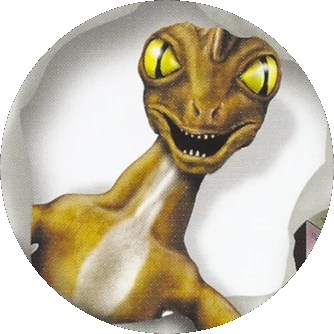You'd think a bird with bright blue and yellow feathers would be easy to spot, but not when its rainforest habitat is just as colorful and the bird usually stays hundreds of feet above the ground. The blue & yellow macaw (also called a parrot) eats fruits and nuts at the tops of tall trees, where it is also safe from enemies. A hard beak helps the bird crack open hard shells and rip into unripe fruit; the macaw also eats dirt (actually clay) to stay healthy.
Rear Gear: This bird's blue tail feathers make up almost half of its body length, and can measure up to one and a half feet long. The bird uses its tail to change direction in flight and balance itself when perched high on tree branches.
Tough Beak: The blue & yellow macaw's sharp, hooked beak is strong enough to crack open any fruits and nuts it finds, and can even break a person's finger. The bird holds food with its talons while ripping it open and eating it.
Living the High Life[]

This macaw's beak slices neatly through unripe fruits.
Blue & yellow macaws usually live in pairs, and sometimes gather in large flocks during their early morning feeding time. These birds almost always stay near the top of the rainforest canopy for several reasons. This is where they find most of the nuts and unripe fruits they eat, and the cover of thick leaves provides protection against predators, such as eagles. Though the blue & yellow macaw is one of the most common tropical birds in its habitat, it's hard to spot. When high up, the bright feathers that give the bird its name camouflage it among green and yellow leaves.
Home Invasion: Though they're social birds, blue & yellow macaws can turn vicious. If good nesting sites are in short supply, this big bird is known to invade other macaw nests, kill any young inside and take over.
Eat Dirt: These tropical birds have a strange habit of gathering near cliff walls made of clay-and eating the clay! Experts think the clay gives the macaws some nutrients, and may also help them digest unripe fruit.
The Breakfast Club[]
- A blue & yellow macaw with a prime nesting hollow trunk of a dead spot-inside the tree-wakes early in the morning and prepares to go forage.
- The bird hooks up with its partner, and the two fly off to a favorite feeding ground. The pair rarely ventures out into the rainforest without each other.
- After flying for more than 10 miles, the birds find other macaws already feasting on some nuts. The birds eat together in peace, but the pairs always stay close to each other.
Trivia[]
- This card is the numerically highest bird card in the collection.
- The card's front illustration is also used in the Wildlife Explorer series, for the Blue & Yellow Macaw's profile. The illustration remains visually the exact same.
- The Blue & Yellow Macaw's Wildlife Explorer card follows the Bald Eagle, who also shared illustrations between the two series.
- The image of the macaw on the back right, and the macaw eating the fruit are also both shared.
- The multi-paneled illustration on the back, "The Breakfast Club", is also used in the Wildlife Explorer series, inside the card. Here, titled "Birds of a Feather", there's an additional second panel of the two flying macaws both sitting atop the trunk the one is sticking their head out of in the first panel.
- The title used on the Weird n' Wild Creatures card is also a reference to the 1985 movie The Breakfast Club.
